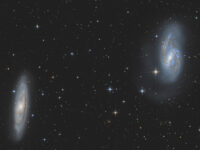As infinite as our universe may seem, everything is destined to come to an end. The question physicists are asking themselves is exactly what that end will look like. With the continuous, accelerating expansion of the universe, one of those theoretical endings predicts the universe will eventually hit a limit where matter will deconstruct into its fundamental components. The force of gravity that is holding objects together will be overpowered, ripping apart the space-time fabric and everything in between, like a rubber band stretched too far. This outcome is better known as the Big Rip Theory.
The force of gravity that is holding objects together will be overpowered, ripping apart the space-time fabric and everything in between, like a rubber band stretched too far.
The heart of this theory finds its origins in the concept of dark energy, a peculiar substance that constitutes 68 percent of the universe with the sole effect of expanding the universe at an accelerating rate. Dark energy is elusive because of its lack of presence. Physicists are aware it is inherently part of space, but its impact in expanding the universe is so slow and gradual that they have to look much closer to find evidence of its existence. Although there is still much research to be done on dark energy, it has been defined previously as a cosmological constant because the same density of dark energy exists in any given area of space — even as the universe expands under its pressure. Due to its consistency, no objects, such as galaxies, are disrupted; only the space in between objects would increase.
To quantify a substance’s evolution over time in the universe, scientists talk about its equation-of-state, also known as w. The w of any cosmological constant is -1, and the same value was assigned to dark energy. However, physicist Robert Caldwell at Dartmouth College and his colleagues decided to explore the possibility of the value of w being less than -1, which is possible if the speed of energy were allowed to surpass the speed of light. As far as we know, nothing is as fast as light in our universe. However, if dark energy increases instead of staying constant, it would have to do so faster than the speed of light for it to rip apart the universe. In the calculations from their 2003 paper, Caldwell and his colleagues found that the data supported values of w less than -1 for dark energy. This new hypothetical version of dark energy was called “phantom dark energy,” and unlike the previous definition of dark energy, it will not stay constant. Instead, it will grow stronger as the universe expands.
A second component plays a role in the Big Rip: the viscosity of the universe. Cosmological viscosity is a measurement of the universe’s stickiness, or how resistant it is to expansion or contraction. In a more recent model developed in 2015 by Marcelo Disconzi of Vanderbilt University and his colleagues, they determined that the universe’s viscosity is low enough for it to expand to an infinite size. Combined with the idea that dark energy will continue to increase in strength, there will come a point where dark energy will overtake the force of gravity.
And so, the Big Rip will unfold like this: the space between galaxies becomes infinitely lonelier as clusters begin to drift apart. Then, stars begin to drift away from their galaxies, and planets drift away from their stars, and moons from their planets. Celestial bodies will begin to explode as they pull themselves apart. Molecules and atoms will split, reducing the universe to its barest forms until it finally cannot handle the pressure anymore, the fabric of space glitching as it tears itself apart. Reality would then be reminiscent of the time before the Big Bang when everything constituted nothing.
Molecules and atoms will split, reducing the universe to its barest forms until it finally cannot handle the pressure anymore.
Of course, this is all in due time –– 22 billion years, in fact, according to Disconzi’s hypothesis. Until then, we will continue to question exactly how our universe’s end will begin.
Sources:
Phys. Rev. (2003). DOI: 10.1103/PhysRevLett.91.071301
Phys. Rev. (2015). DOI: 10.1103/PhysRevD.91.043532
Image courtesy of Pxfuel





